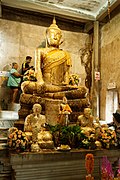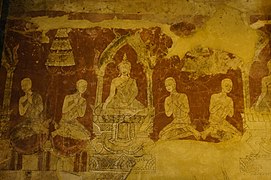Wat Bang Kung
History
In 1765, Burmese troops attacked the Ayutthaya Kingdom. Ekkathat, king of Ayutthaya, commanded the navy and built a wall around Wat Bang Kung as an encampment for his soldiers. The Burmese troops, moving along the Mae Klong river, overran the camp, which was eventually abandoned.
In 1767, Taksin, king of Thonburi, restored the country's independence and commanded Chinese settlers from Rayong, Chonburi, Ratchaburi, and Kanchanaburi to form a guard and protect the camp, which was subsequently called Bang Kung Chinese Camp.
In 1768, Burmese troops, led by the king of Ava, ordered his army and navy to besiege the camp again. Defended by Chinese troops, it was nearly lost once more, until Taksin and Maha Sura Singhanat joined the battle and defeated the Burmese.
Architecture
The temple is covered with various roots, which help support the ubosot. Inside, there is a statue of Buddha and a mural depicting the story of his life. The Fine Arts Department registered Wat Bang Kung as a national archaeological site on 18 December 1996.
Gallery
-
Buddha inside the ubosot
-
Roots encircling the ubosot
-
Mural inside the ubosot
References
- ^ "Samutsongkhram – Evidence". samutsongkhram.go.th. Retrieved 26 September 2016.
- ^ "Attractions: Bang Kung Camp". tourismthailand.org. Retrieved 27 September 2016.
- ^ "Announcement registered archaeological sites and historic land zoning (The Fine Arts Department)" (PDF). 27 September 2016. Archived from the original (PDF) on 4 March 2016.
External links
 Media related to Wat Bang Kung, Samut Songkhram at Wikimedia Commons
Media related to Wat Bang Kung, Samut Songkhram at Wikimedia Commons



